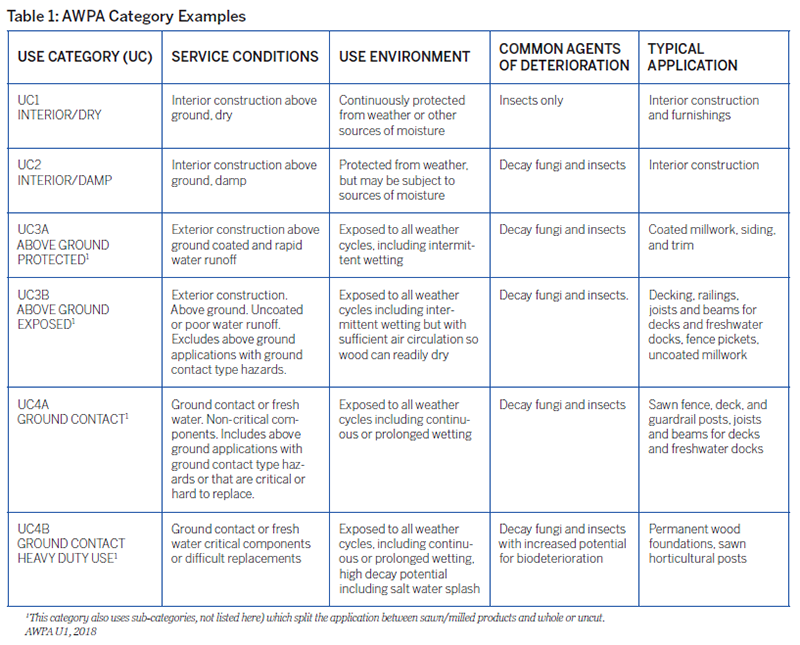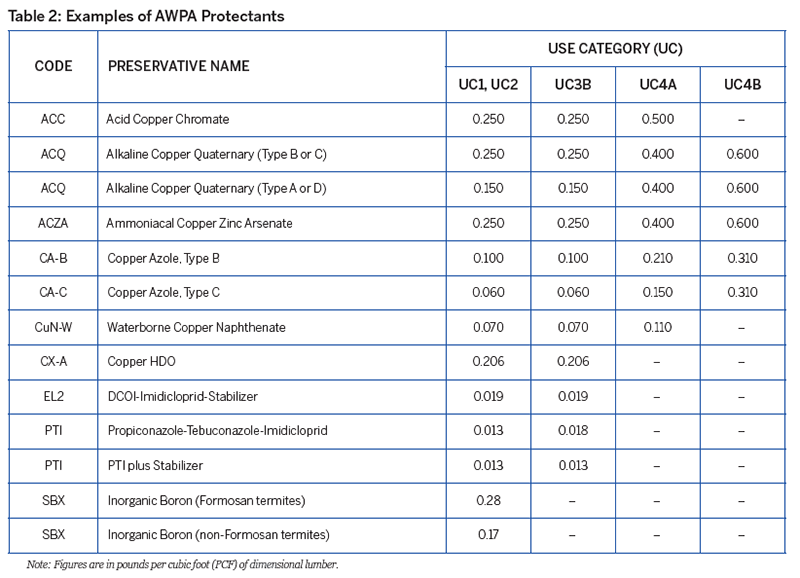A decade ago, the United States market voluntarily abandoned the long-standing wood preservative and treatment method where an arsenic and copper compound was forced into the fibers of the lumber. When the fluid was removed, this preservative was left behind and was extremely effective at retarding decay. The copper displaced water (and the microbes that cause rot), and the arsenic deterred wood-consuming insects like ants and termites. Contrary to popular belief, there was never any evidence that these chemicals would leach from the product or caused harm from splinters. In fact, the research proved exactly the opposite, but the media furor prevailed, and manufacture of the product was largely (though not completely) abandoned. The valid concerns involved breathing the dust when cutting and working with the material, and the toxicity of the ash if the wood was burned. So, if you have structures that are constructed with "old," pressure-treated lumber ("chromated copper arsenate, CCA"), no worries! When the time comes to replace it, don't burn it or cut it any more than necessary to get it to the landfill. Yes, the landfill. If left in a pile, someone will eventually decide to burn it, and that will create problems.
What about the new stuff? Anyone who's tried to purchase lumber since the end of the CCA era has encountered a confusing alphabet soup of codes and letters on the product tags. That's left a lot of people wondering, "What's the best one?" The more appropriate question should be, "What's the right one for this job?" Even more interestingly, with all of the changes to the industry, you may be surprised to find out there may be several correct answers for even a simple job like a deck.
By the Letters
Until 1993, the American Wood Preservers Bureau (AWPB) was the trade organization that managed the industry under the previous CCA formulation. The products of that day were primarily in two categories: above ground and ground contact. The ground contact products (AWPB LP-22) contained about 0.40 pounds of CCA per cubic foot of wood product, and the above ground product (AWPB LP-2) contained about 0.25 pounds per cubic foot. As we will see shortly, the new system acknowledges that a much wider range of real-world applications demands a much wider range of treatments.
The American Wood Protection Association (AWPA) replaced the AWPB in 1993. You should start with the AWPA to find the most relevant information for camp's applications.
Another kindred trade group to the AWPA with which camps should be familiar is the Western Wood Preservers Institute (WWPI). Although its core membership is focused on western North America, WWPI is the industry leader in the research, development, and maintenance of standards for wood products used in extreme, sensitive environments (such as for piers and submerged pilings) or for special uses (like utility poles). This organization has a more customer-oriented website (preservedwood.org), which includes a number of great resources and even a free app for iPhones and Androids to assist in the selection of the right product for your project.
AWPA Categories
A host of different chemicals in a wide range of concentrations make up the new preserved lumber treatments. For example, boron/borax is a well-known pesticide and has replaced the arsenic in some preservative formulas where the wood is not exposed to water but where insect attack is a concern (interior dry locations). So, instead of trying to shoehorn a certain product into a use, the AWPA defined the use and assigned a category so products could be developed to match those conditions. Table 1 provides a handful of examples of the use categories the AWPA has developed.

For each of the categories, there are standard formulas and concentrations of the preservatives that will provide the required level of protection. Table 2 lists just a few of the more common of 44 protectants listed in the AWPA standard:
The complete tables and the detailed explanations are available from the AWPA, and can be purchased for download as an Adobe PDF file for a nominal fee.

So, what do you do with all of this information? Each piece of treated lumber has a tag stapled on the end. It contains all of this information in a code or shorthand format. Now that you know where to go to find the key to the code, you would be able to decipher the tag shown.
You can see that the product use category code is "UC3B" for above-ground use, with 0.250 pounds per cubic foot (PCF) of alkaline copper quaternary (ACQ) protectant. This piece of lumber is treated to resist damage from fungi and insects, even without a protective coating like paint or stain. In short, this is a good product for the exposed surfaces of a deck or walkway, but not for the piers and posts in contact with the ground.
As the category codes were developed to accommodate very specific regional conditions (for example, only a few areas in the country contend with Formosan termites), not every product is available in every area. Local lumber yards and home stores should be reserving space for just those products that are applicable to their region. Moreover, if the wholesale cost for a certain product is the same for two concentrations, they may carry only the greater concentration, so they don't have to stock two and set the stage for customer confusion.
Choosing Fasteners
The only point left to work through now is fastening. As you can see from Table 2, copper is a common component of these chemical treatment cocktails. In the "old" CCA, the chromium and arsenic worked together to actually slow corrosion, so even "bright" fasteners would last a long time. When CCA was first replaced, though, the treatment compound was a super-high concentration of copper solution. You may recognize some of those projects today; as the copper in the surface material ages and oxidizes, it turns an ever-brighter green (like the Statue of Liberty). Builders discovered very quickly that when traditional fasteners like nails and screws were exposed to water and these wooden components, they would rapidly corrode and fail. Even though the formulas have changed over time, copper in the treated wood still accelerates metal corrosion. ACQ, as a product we've already talked about, is actually twice as corrosive as CCA. So, for the longevity and safety of any project, it is critical that you choose and use fasteners that are intended to be used with the type and concentration of preservative in your project. Generally speaking, specially coated and hot-dipped galvanized (HDG) nails, screws, and fixtures have been developed to provide the best service for treated lumber. These are a dull gray and feel sticky or rough. You will find that HDG is generally cheaper than their polymer-coated counterparts. That's because the process itself is cheaper. However, the zinc is sacrificial, and from the day it is installed, it will begin to dissolve until it is no longer protecting the steel nail inside. Corrosion will accelerate from there. And while a polymer coating will make driving easier (it's smooth and HDG is pretty rough), it also will eventually deteriorate, and the zinc beneath will begin to act just like the uncoated fastener. The coating buys life for the project. Lastly is stainless steel. This is the go-to material whenever you need the project to last a long, long time (or where money is no object).
Whatever you do, do not mix fasteners in a project. The different materials and finishes may well set up corrosion patterns between them using the wood as a bridge just like the acid in a battery provides a path for electrons. For example, don't use stainless steel nails with galvanized joist hangers. Pick one kind of metal product for a whole project and stay with it. Rely on the hardware manufacturer's guidance when choosing materials and coating thicknesses instead of the lumber manufacturer. In this case, G-185 (a thicker coating) is almost always better. After all, it's their materials you're concerned about failing. In short, "whatever we have in the shop" is a very bad approach.
Understanding the products available in the market and matching those with the environment in which they will perform will ensure your project lasts longer and looks better than ever before. Take the time to learn how to read the tags on products available in your area so you spend money on protection where you need it and skimp where it makes sense. You'll protect the environment, your guests, and your wallet in the long run.
Rick Stryker is a professional engineer who is passionate about camps and the opportunities that they provide. He's always delighted to answer email questions at [email protected].
Photo used with permission of The Family Handyman.
